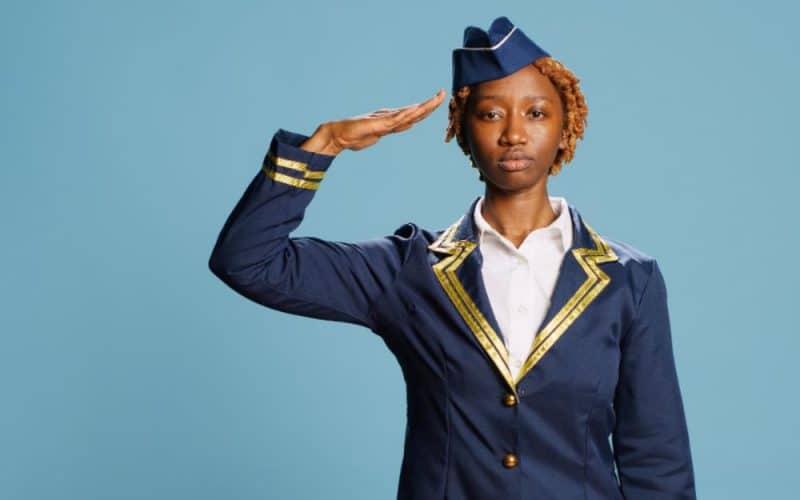Flight attendants require at least a year of work experience to gain customer service skills. Once hired, they participate in three to six weeks, and sometimes up to six months, of training provided by the airline. During this training period, flight attendants learn safety and emergency procedures, first aid, flight regulations and job duties. They also take practice flights to apply their new skills and knowledge.
All flight attendants complete this initial training to get certified by the Federal Aviation Administration (FAA). This role may complete additional job training, depending on the airline employer.
Currently, the average hourly salary for an International Flight Attendant in the United States is $22.63 an hour. While this can go as high as $47.12 and as low as $5.29, the majority of International Flight Attendant salaries currently range between $17.07 (25th percentile) to $24.04 (75th percentile) across the United States.
The average salary range for an International Flight Attendant varies greatly (by as much as $6.97), which suggests there may be many opportunities for advancement and increased pay based on skill level, location and years of experience.
Who is a flight attendant?
Flight attendants work for private and commercial airline companies to keep passengers safe and comfortable. They help passengers get seated, demonstrate how to use the plane’s safety equipment, including seat belts, and provide snacks, beverages and other services. Legally, all airlines require flight attendants on staff to ensure passengers’ safety.
Additional flight attendant responsibilities include:
- Attending preflight briefings with the pilots to get flight information for each trip
- Inspecting emergency equipment before each flight
- Ensuring the plane’s cabin is clean and well-stocked with food and drinks
- Lifting heavy luggage into overhead bins and closing them before takeoff
- Making sure all passengers are prepared for takeoff and landing
- Helping passengers with special needs, small children or medical assistance needs
- Responding to disruptive passengers and monitoring the plane for suspicious behaviour
- Helping passengers find their seats, locating and using safety equipment, putting out potential fires and directing evacuations in case of emergencies
- Reporting safety or medical issues that occurred on a flight
- Reviewing company policies and health guidelines for passengers
Requirements to become a flight attendant
To get hired as a flight attendant, you’re required to be at least 18 or 21 years old, depending on the state or employer, have a current passport, have at least 20/40 vision and pass a drug test and background check. Additional requirements may include passing a medical examination and meeting an airline’s height requirements.
Here are some other requirements to become a flight attendant:
Education
Flight attendants have at least a high school diploma or GED. Some airlines may prefer a candidate with an associate or a bachelor’s degree in subjects like:
- Hospitality
- Public relations
- Tourism
- Communication
- Business
- Nursing
As an alternative, some people enrol in flight attendant school. If you wish to work on international flights, you may find it helpful to take foreign language classes.
Certifications
Flight attendants require certification with one of the following credentials:
FAA Certificate of Demonstrated Proficiency
This certificate, which flight attendants earn by completing their on-job training and passing an exam, is mandatory. Flight attendants train for and become certified for each type of aircraft they work on. They also continue receiving training each year to stay certified.
Flight Attendant Certificate Courses
Organizations such as Inflight Institute offer certification programs by type of airline: charter, regional, national or international. Their partner airlines require flight attendants to take flight attendant certificate courses, which cover topics ranging from aviation terminology to safety procedures to passenger handling, before being hired.
Training
Many flight attendants require a year or two of work experience to gain customer service skills. Once hired, they participate in three to six weeks, and sometimes up to six months, of training provided by the airline. During this training period, flight attendants learn safety and emergency procedures, first aid, flight regulations and job duties. They also take practice flights to apply their new skills and knowledge.
All flight attendants complete this initial training to get certified by the Federal Aviation Administration (FAA). This role may complete additional job training, depending on the airline employer.
Skills
In general, flight attendants enjoy working with people and have strong interpersonal and customer service skills. For many flight attendants, the ability to travel to different locations makes it worth the varied hours, so consider if this is a good lifestyle fit for you due to the long and unusual hours.
Some soft skills aspiring flight attendants can develop include:
- Attention to detail. Flight attendants monitor passengers for issues or suspicious activities. They’re meticulous when doing safety checks on equipment and for people.
- Communication. Individuals in this role can communicate clearly and confidently when giving safety demonstrations and interacting with passengers and crew. They’re also courteous and have strong listening skills.
- Customer service. Part of a flight attendant’s job is providing hospitality, which can include answering questions, directing passengers to their seats and assisting with storing luggage in the overhead bins. They’re friendly and patient when providing services to ensure passengers have a positive flight.
- Stamina. Flight attendants often work long hours, respond to challenging passengers and handle heavy items, such as luggage and service carts.
- Efficiency. Flight attendants work quickly and efficiently to complete preflight tasks for an on-time departure.
- Leadership. In emergencies, flight attendants take charge and make quick decisions to guide passengers to safety.
Flight attendant salary by state
| State | Annual Salary | Monthly Pay | Weekly Pay | Hourly Wage |
|---|---|---|---|---|
| Washington | $55,017 | $4,584 | $1,058 | $26.45 |
| Delaware | $51,534 | $4,294 | $991 | $24.78 |
| Virginia | $50,647 | $4,220 | $973 | $24.35 |
| Maryland | $49,874 | $4,156 | $959 | $23.98 |
| New York | $49,812 | $4,151 | $957 | $23.95 |
| Vermont | $48,783 | $4,065 | $938 | $23.45 |
| Nebraska | $48,708 | $4,059 | $936 | $23.42 |
| Oklahoma | $47,170 | $3,930 | $907 | $22.68 |
| California | $47,096 | $3,924 | $905 | $22.64 |
| Massachusetts | $46,520 | $3,876 | $894 | $22.37 |
| Alaska | $46,108 | $3,842 | $886 | $22.17 |
| Maine | $45,875 | $3,822 | $882 | $22.06 |
| Pennsylvania | $45,626 | $3,802 | $877 | $21.94 |
| Oregon | $45,476 | $3,789 | $874 | $21.86 |
| North Dakota | $45,458 | $3,788 | $874 | $21.85 |
| Idaho | $45,142 | $3,761 | $868 | $21.70 |
| New Jersey | $45,115 | $3,759 | $867 | $21.69 |
| Texas | $44,920 | $3,743 | $863 | $21.60 |
| Colorado | $44,627 | $3,718 | $858 | $21.46 |
| Hawaii | $44,609 | $3,717 | $857 | $21.45 |
| Wisconsin | $44,569 | $3,714 | $857 | $21.43 |
| New Hampshire | $44,434 | $3,702 | $854 | $21.36 |
| Wyoming | $43,613 | $3,634 | $838 | $20.97 |
| Nevada | $43,596 | $3,633 | $838 | $20.96 |
| South Dakota | $42,963 | $3,580 | $826 | $20.66 |
| Indiana | $42,951 | $3,579 | $825 | $20.65 |
| Minnesota | $42,921 | $3,576 | $825 | $20.64 |
| New Mexico | $42,815 | $3,567 | $823 | $20.58 |
| Rhode Island | $42,123 | $3,510 | $810 | $20.25 |
| Arizona | $42,063 | $3,505 | $808 | $20.22 |
| Ohio | $41,757 | $3,479 | $803 | $20.08 |
| Montana | $41,430 | $3,452 | $796 | $19.92 |
| Connecticut | $41,173 | $3,431 | $791 | $19.80 |
| Illinois | $41,164 | $3,430 | $791 | $19.79 |
| Iowa | $40,950 | $3,412 | $787 | $19.69 |
| Alabama | $40,912 | $3,409 | $786 | $19.67 |
| Mississippi | $40,816 | $3,401 | $784 | $19.62 |
| Tennessee | $39,867 | $3,322 | $766 | $19.17 |
| Utah | $39,837 | $3,319 | $766 | $19.15 |
| Missouri | $39,753 | $3,312 | $764 | $19.11 |
| South Carolina | $39,343 | $3,278 | $756 | $18.92 |
| North Carolina | $38,531 | $3,210 | $740 | $18.52 |
| Kansas | $38,428 | $3,202 | $739 | $18.48 |
| Georgia | $38,113 | $3,176 | $732 | $18.32 |
| Louisiana | $37,474 | $3,122 | $720 | $18.02 |
| Michigan | $36,981 | $3,081 | $711 | $17.78 |
| Kentucky | $36,948 | $3,079 | $710 | $17.76 |
| West Virginia | $35,237 | $2,936 | $677 | $16.94 |
| Arkansas | $35,127 | $2,927 | $675 | $16.89 |
| Florida | $33,729 | $2,810 | $648 | $16.22 |
States with highest highest-paying flight attendant salaries
There are 10 cities where the typical salary for an International Flight Attendant job is above the national average. Topping the list is San Francisco, CA, with Beverly Hills, CA and Cupertino, CA close behind in the second and third positions. Cupertino, CA beats the national average by $11,057 (23.5%), and San Francisco, CA furthers that trend with another $13,064 (27.8%) above the $47,079 average.
With these 10 cities having average salaries higher than the national average, the opportunities for economic advancement by changing locations as an International Flight Attendant appears to be exceedingly fruitful.
Finally, another factor to consider is the average salary for these top ten cities varies very little at 6% between San Francisco, CA and Beverly, MA, reinforcing the limited potential for much wage advancement. The possibility of a lower cost of living may be the best factor to use when considering location and salary for an International Flight Attendant role.
| City | Annual Salary | Monthly Pay | Weekly Pay | Hourly Wage |
|---|---|---|---|---|
| San Francisco, CA | $60,143 | $5,011 | $1,156 | $28.92 |
| Beverly Hills, CA | $59,363 | $4,946 | $1,141 | $28.54 |
| Cupertino, CA | $58,136 | $4,844 | $1,118 | $27.95 |
| San Jose, CA | $57,871 | $4,822 | $1,112 | $27.82 |
| Oakland, CA | $56,617 | $4,718 | $1,088 | $27.22 |
| Vallejo, CA | $56,609 | $4,717 | $1,088 | $27.22 |
| Hayward, CA | $56,520 | $4,710 | $1,086 | $27.17 |
| Ashland, CA | $56,515 | $4,709 | $1,086 | $27.17 |
| Antioch, CA | $56,407 | $4,700 | $1,084 | $27.12 |
| Beverly, MA | $56,250 | $4,687 | $1,081 | $27.04 |
How to become a flight attendant
Here’s an overview of how to become a flight attendant in ten steps:
- Get a high school diploma. The minimum education requirement for flight attendants is a high school diploma or GED.
- Talk to a career counsellor. Speak with a counsellor about your intention to become a flight attendant. Your career counsellor can help you select the most beneficial coursework to prepare you for this role.
- Earn a college degree. While most airlines hire flight attendants without degrees, an associate’s or bachelor’s degree in public relations may improve your job opportunities.
- Build customer service skills. Consider working for a year or two in a hospitality or service job to develop your customer service skills. You might work at a restaurant, hotel or any role that requires interacting with others.
- Practice your interview skills. Show you’re knowledgeable of flight attendant duties and skills and you possess customer service skills. Prepare a resume in advance to prove your education and customer service experience.
- Apply for jobs. You can apply for flight attendant positions if you’re over 18 years old and have good health and vision.
- Train. If an airline hires you, you can train for weeks or months to prepare for FAA certification. Training courses include performing first aid, responding to challenging flight or passenger situations, evacuating, putting out fires and learning survival skills and self-defence.
- Get certified. After you have completed initial training, pass the FAA’s exam to become certified and legally allowed to work as a flight attendant.
- Complete reserve status. New flight attendants start on reserve status. During this time, you’re on call to fill in for other flight attendants or extra flights, typically lasting one year.
- Advance in your career. After you gain enough experience, you may have the seniority to choose your base, routes and schedule. You might also mentor, recruit, train or manage other flight attendants and help with tasks such as scheduling.
What it is like to work as a flight attendant
Flight attendants can work part-time or full-time for commercial, corporate, regional or international airlines. They work unconventional and lengthy hours and schedules, including being on-call or coming to work with last-minute notice, because airlines operate day and night, year-round, on holidays and weekends.
Most airlines ensure flight attendants work no more than 12 hours a day, but international flights may require them to work longer. The FAA requires flight attendants to have at least nine hours off between shifts.
They often spend nights in hotels between flights and might be away from home for several days. Flight attendants spend part of their workdays in the air and part on the ground preparing or waiting for the next flight. When flying, they work in the plane’s cabin with crew members.
A flight attendant’s job can be challenging at times, as they respond to potential emergencies, experience air turbulence and remain on their feet for long periods.
Recommended Articles
- HOW DOES SALARY PAY WORK: How Salaried Workers are Compensated
- HOW TO BECOME A PERSONAL SHOPPER: All You Need To Know
- HOW DO FINANCIAL ADVISORS MAKE MONEY? What Does a Financial Advisor Do To Earn
- How To Start Affiliate Marketing With No Money: Starting Guide
- HOW TO BECOME A PHARMACIST: Become A Pharmacist With These 5 Steps
- POST AFFILIATE PRO: Meaning, How It Works, and Review






